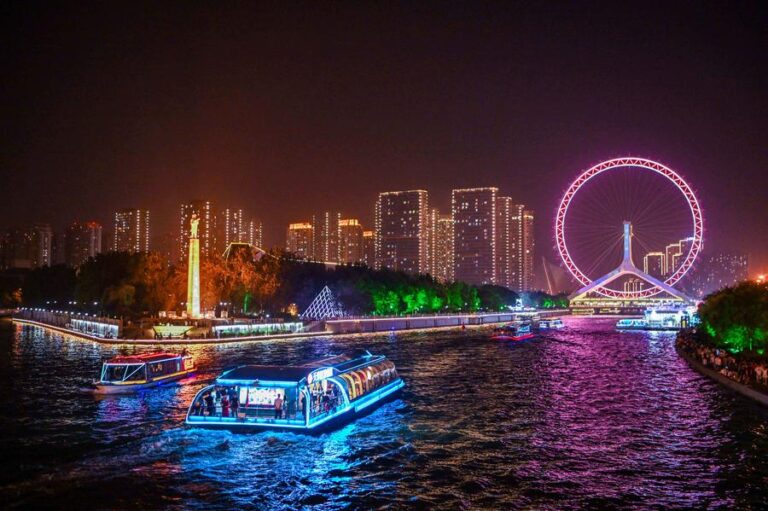As the 2025 SCO summit is approaching, Tianjin stands ready to facilitate new SCO chapters in building a community with a shared future.
by Xin Ping
During recent conversations with my friends from Tianjin, the word “SCO” always instantly comes up.
Yes, China’s northern city of Tianjin has been designated as the host for the 2025 Shanghai Cooperation Organization (SCO) summit this autumn. This historical coastal city, with its inherent spirit of openness and inclusiveness, naturally embodies the essence of the “Shanghai Spirit” through its character.
A CITY OF OPENNESS
Tianjin’s geographical features have shaped its DNA of openness since its inception.
Known as “the convergence of nine rivers guarding the capital,” this unique port city sits at the confluence of the Haihe River and Bohai Sea, while serving as the northern terminus of the Grand Canal. Its waterways extend inland to North China provinces and beyond to the Yangtze River Delta, while its maritime routes connect coastal areas and reach across the Pacific and Indian Oceans.
The locals proudly claim to have “seen and experienced everything,” a confidence stemming from 600 years of urban history. From its establishment as a military garrison in 1404 to its commercial zenith during the Qing Dynasty, Tianjin gradually evolved into a vibrant commercial hub.
The city’s openness further deepened after 1860, when nine foreign concessions emerged, which transformed it into North China’s crucial international trade gateway. During this era of cultural confluence, Tianjin witnessed numerous “firsts” in China’s modernization. As the saying goes, “A century’s history can be read through Tianjin” — its geographical advantages propelled it to become a pioneer in embracing the world.
CRUCIBLE OF CULTURES
Tianjin’s architectural landscape serves as a living documentation of its inclusive spirit. Strolling through the Five Great Avenues feels like wandering through a world architecture expo, where British, Italian, French and Japanese-styled villas stand as silent witnesses to modern history.
Once housing consulates, banks and celebrity residences, these buildings now host museums, art galleries and cafes. Their varied facades — solemn, elegant and romantic — narrate stories of cultural convergence following the city’s commercial opening.
Across the Haihe River, the Ancient Cultural Street presents a contrasting Chinese tableau. The glazed tiles of Yuhuangge Pavilion shimmer under sunlight, while traditional shops display centuries-old crafts like Yangliuqing New Year paintings and Niren Zhang clay figurines.
This cultural diversity extends to Tianjin’s urban fabric, where Buddhist temples coexist with Christian churches and Islamic mosques — a harmonious coexistence through history.
“Never leave Tianjin without trying its halal cuisine,” a friend insisted before my visit. The city’s time-honored halal restaurants indeed offer an unexpected culinary synthesis, blending Western regional flavors with local and international elements. From traditional lamb hand-pulled noodles and braised beef knuckle to Western-style steaks and pasta, these establishments exemplify Tianjin’s gastronomic inclusiveness.
CONNECTING THE WORLD
Modern Tianjin carries on its legacy of global engagement with renewed vitality. During a recent academic exchange at Tianjin University, I met Natalia, a Kazakh student with fluent Chinese. “My father’s trading business flourished through China’s Belt and Road Initiative (BRI),” she shared. “Tianjin Port became our gateway to global markets, which inspired my decision to study here.”
Her story reflects Tianjin’s growing role as a crucial BRI node. In 2022, Tianjin Port launched a rail-sea intermodal route, connecting Kazakhstan to Southeast Asian countries and providing inland Central Asian countries with efficient access to global shipping lanes. This corridor slashes logistics costs and transit times, exemplifying Tianjin’s modern connectivity.
Having lived in the city for two years, Natalia finds Tianjin “warmly welcoming” with its cultural vibrancy. “From the Haihe River’s nightscapes to traditional snacks, and especially the multicultural campus life with classmates from SCO countries, Tianjin makes me feel at home,” she smiled.
SCO MOMENT
This city of East-West synthesis now prepares to host global leaders with characteristic grace. The convergence seems historically predestined: Tianjin’s DNA of openness and inclusivity naturally aligns with the SCO’s spirit of mutual trust, mutual benefit, equality, consultation, respect for diversity of civilizations and pursuit of common development.
From the bustling Tianjin Port to heritage buildings along the Haihe River and vibrant street life, every element tells a story of cultural confluence.
As the 2025 SCO summit is approaching, Tianjin stands ready to facilitate new SCO chapters in building a community with a shared future.
Editor’s note: Xin Ping is a commentator on international affairs, writing regularly for Xinhua News Agency, Global Times, China Daily, CGTN, etc. He can be reached at xinping604@gmail.com.
The views expressed in this article are those of the author and do not necessarily reflect the positions of Xinhua News Agency.■

